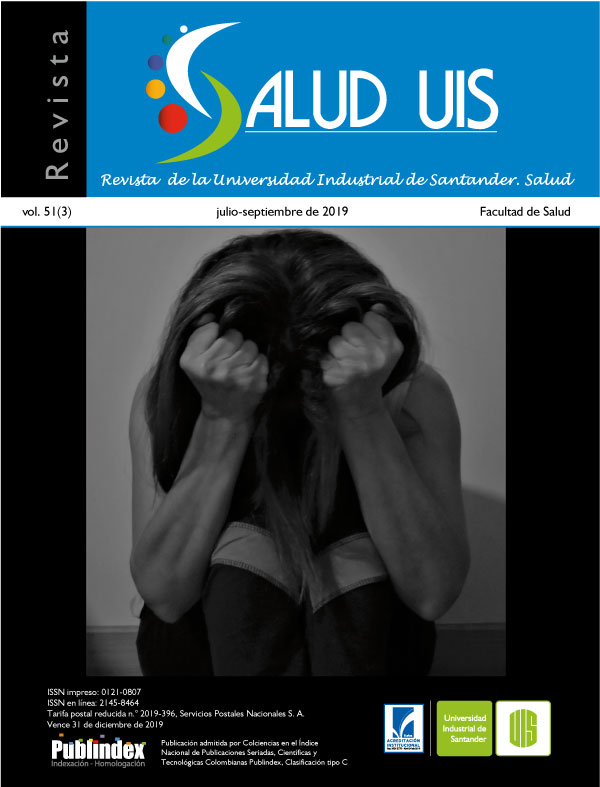Abstract
Introduction: In the care health processes that require follow-up, such as prenatal care, users satisfaction can
contribute to its outcome. The perceived quality, estimated through users satisfaction, approximates the measurement
of prenatal care quality. Objective: To establish the level of satisfaction among pregnant women with prenatal care in a health institution in Montería (Colombia). Methods: using the Epidat 3.1 program. Averages, medians and proportions were estimated according to the quantitative or qualitative variables. The statistical association was explored using the Student´s t test for the continuous variables and the x2 test for the categorical variables, and OR was estimated (95%CI) assuming as a case the satisfaction with the prenatal control. Results: Of the 178 women interviewed, 96% reported feeling satisfied with antenatal consultation. They received information on: Human Immunodeficiency Virus test 83.7%, laboratory tests 85.4%, obstetric danger signs 93.8%, maternal nutrition 86.5%, breastfeeding 76.4%, family planning 64%, newborn care 71.9%. The average of age (22.7 versus 25.1 years) and gestational age (11.1 versus 14.9 weeks) are lower in
women satisfied with antenatal consultation (p<0.001). Other variables associated with satisfaction in antenatal
care: complete medication delivery (OR 8.6 95%CI 1.6-46.2), timely laboratory results (OR 6 95%CI 1.2-28.9), and
information provided on obstetric danger signs (OR 20.3 95%CI 3.7-112) and maternal nutrition (OR 5.3 95%CI
1.16-25.16). Conclusion: In addition to the influence of demographic and obstetric variables and attributes of
quality care health, it is important to note how information and health education are also associated with women´s
satisfaction with antenatal care.
References
2. Instituto Nacional de Salud. Mortalidad materna Colombia; 2017.
3. Instituto Nacional de Salud. Morbilidad materna extrema Colombia; 2017.
4. Instituto Nacional de Salud. Mortalidad perinatal y neonatal tardía; 2017.
5. Bahrami N, Simbar M, Bahrami S. The effect of prenatal education on mother’s quality of life during first year postpartum among Iranian women: a randomized controlled trial. Int J Fertil Steril. 2013; 7(3): 169-174.
6. Ministerio de salud y protección social. Colciencias. Guías de práctica clínica para la prevención, detección temprana y tratamiento del embarazo, parto o puerperio. Bogotá: Ministerio de salud y protección social-Colciencias, 2013.
7. Cáceres-Manrique FM. El control prenatal: una reflexión urgente. Rev Colomb Obstet Ginecol. 2009; 60(2): 165-170.
8. Jiménez Pérez JM, García Villanueva S. Evaluación de la satisfacción del usuario del sistema nacional de salud en el último quinquenio. Rev Enferm. CyL. 2015; 7(2): 21-34.
9. Reynaldos-Grandón K, González-Pinilla G, Guerra-Díaz X, Gutiérrez-Fuenzalida F, Santibáñez-Muñoz L. Factores mal evaluados en encuestas de satisfacción aplicadas a usuarios de atención primaria en Latinoamérica. Rev Enferm Act Costa Rica. 2017; 33. doi: 10.15517/REVENF.V0I33.29156.
10. Castillo I, Villarreal M, Olivera E, Pinzón A, Carrascal H. Satisfacción de usuarias del control prenatal en instituciones de salud públicas y factores asociados. Cartagena. Hacia Promoc Salud. 2014; 19(1): 128-140.
11. Do M, Wang W, Hembling J, Ametepi P. Quality of antenatal care and client satisfaction in Kenya and Namibia. Int J Qual Health Care. 2017; 29(2): 183-193. doi: 10.1093/intqhc/mzx001.
12. Diamond-Smith N, Sudhinaraset M, Montagu D. Clinical and perceived quality of care for maternal, neonatal and antenatal care in Kenya and Namibia: the service provision assessment. Reprod Health. 2016; 13(1): 92. doi: 10.1186/s12978-016-0208-y.
13. Kruk ME, Chukwuma A, Mbaruku G, Leslie HH. Variation in quality of primary-care services in Kenya, Malawi, Namibia, Rwanda, Senegal, Uganda and the United Republic of Tanzania. Bull World Health Organ. 2017; 95(6): 408-418.
14. Leslie HH, Sun Z, Kruk ME. Association between infrastructure and observed quality of care in 4 healthcare services: A cross-sectional study of 4,300 facilities in 8 countries. PLoS Med. 2017; 14(12). doi: 10.1371/journal.pmed.1002464.
15. Tiga-Loza D, Villar-Centeno L, Güiza-Sanabria D, Martínez-Vega R. Validez y confiabilidad de un instrumento de satisfacción del usuario con síndrome febril agudo. Rev Salud Pública. 2010; 12(5): 820-832.
16. Zamora S. Satisfacción sobre la infraestructura y la calidad de atención en la consulta de Gineco-Obstetricia de un establecimiento de atención primaria. Horiz. Med. 2016; 16 (1): 38-47.
17. Miranda-Mellado C. Factores de capacidad en el uso de control prenatal adecuado en gestantes de Sincelejo (Colombia). Salud Uninorte. 2016; 32 (3): 436-451.
18. Rivera P, Carvajal R, Mateus J, Arango F, Valencia J. Factores de servicios de salud y satisfacción de usuarias asociados al acceso al control prenatal. Hacia Promo Salud. 2014; 19(1): 84-98.
19. Tocchioni V, Seghieri C, De Santis G, Nuti S. Sociodemographic determinants of women’s satisfaction with prenatal and delivery care services in Italy. Int J Qual Health Care. 2018; 30(8): 594-601. doi: 10.1093/intqhc/mzy078.
20. Oladapo OT, Osiberu MO. Do sociodemographic characteristics of pregnant women determine their perception of antenatal care quality? Matern Child Health J. 2009; 13: 505-511. doi: 10.1007/s10995-008-0389-2.
21. Moraga H, González R. Satisfacción del usuario que requiere exámenes de laboratorio urgentes, Costa Rica. Rev Costarric Salud Pública. 2011;
20(1): 44-48.
22. Vera J, Trujillo A. El efecto de la calidad del servicio en la satisfacción del derechohabiente en instituciones públicas de salud en México. Contad Admin. 2018; 63(2): 1-22.
23. Wambua JM, Mbayaki R, Munyao PM, Kabue MM, Mulindi R, Change PM, et al. Client satisfaction determinants in four Kenyan slums. Int J Health Care Qual Assur. 2015; 28(7): 667-677. doi: 10.1108/IJHCQA-12-2014-0110.
24. Ministerio de Salud de Colombia. Resolución 8430 de 1993. Por la cual se establecen las normas científicas, técnicas y administrativas para la investigación en salud.

This work is licensed under a Creative Commons Attribution 4.0 International License.
